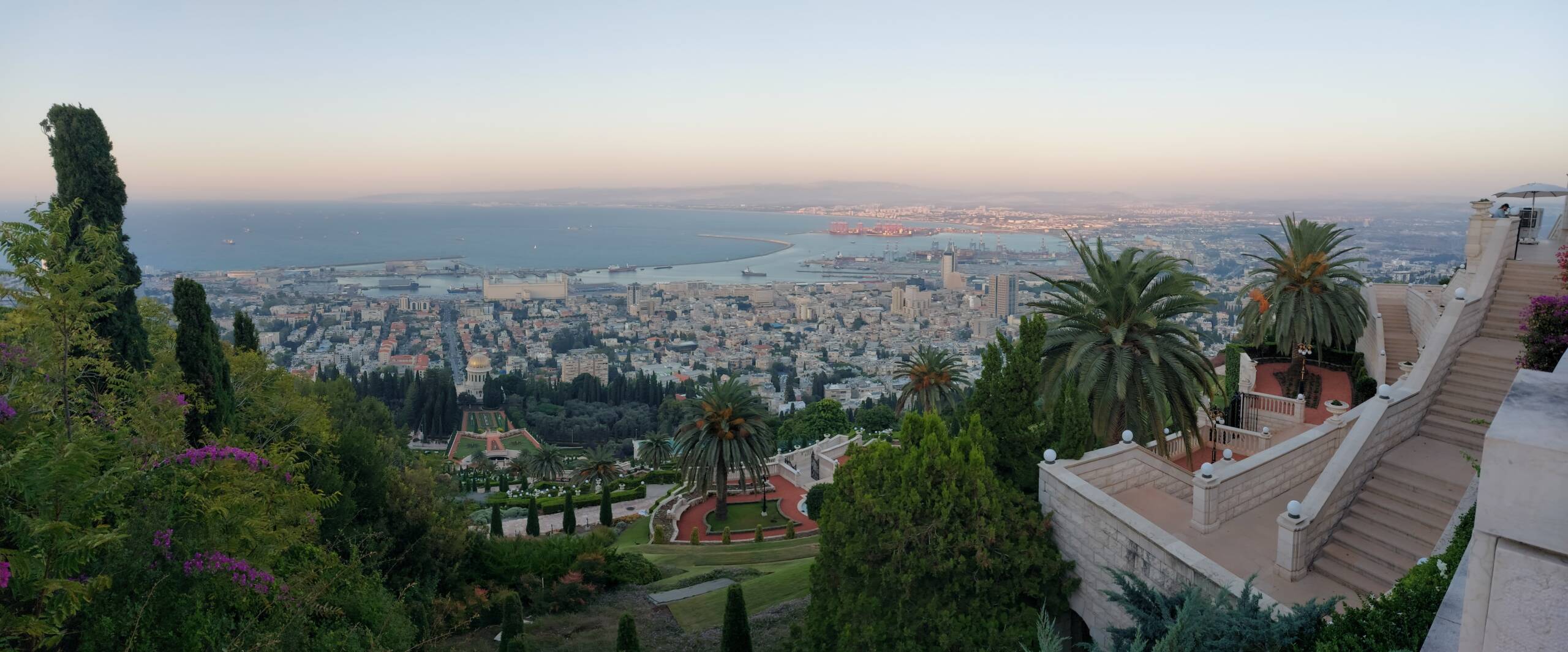From this elevated viewpoint, Haifa reveals itself in a breathtaking sweep of contrasts, a city where manicured beauty and raw urban energy flow into one another against the backdrop of the Mediterranean Sea. The Baháʼí Gardens cascade down the slopes of Mount Carmel in perfect symmetry, their lush greenery, neatly lined cypress trees, and bright flowerbeds creating a staircase of serenity that leads the gaze straight to the golden dome of the Shrine of the Báb. The shrine gleams like a jewel at the heart of the city, its presence radiating both spiritual significance and architectural grace. From here, the terraces seem endless, each level opening into the next, offering order and tranquility in the midst of a city that has long been shaped by complexity and diversity.

Beyond the gardens, Haifa stretches outward, a vibrant and layered city. The neighborhoods climb and spread across the Carmel hills, each corner marked by a different rhythm of life. The old stone houses and modern high-rises blend into a mosaic, speaking of Haifa’s history as a city of workers, immigrants, and seafarers. The straight avenue that runs from the shrine down to the waterfront acts like a visual bridge, linking the sacred gardens to the bustling port, as if reminding the viewer that Haifa is both a place of contemplation and commerce. In the harbor, cranes rise like mechanical trees, container ships are docked and waiting, and the curved breakwater stretches far into the sea to shield the bay. It is here that Haifa shows its economic pulse, the steady beat of trade and industry that connects Israel to the wider Mediterranean.
The evening light softens everything, wrapping the city in a gentle glow that blends the sea with the sky in pastel shades of rose, lavender, and fading blue. The ships anchored offshore look almost like quiet silhouettes, patiently resting on the horizon. To the right, the modern towers of Haifa catch the last golden rays, standing as symbols of the city’s present and future, while the industrial sprawl of the port radiates red and orange lights as evening activity begins. To the left, the natural curve of the bay draws the eye into a dreamy distance, beyond which the Galilee hills fade into the horizon like a watercolor wash.
Up close, the terraces of the gardens whisper another story. The white stone balustrades gleam with a quiet elegance, the stairways curve gracefully, and the palms sway ever so slightly with the soft evening breeze. The contrast between the ordered silence of the gardens and the living, breathing complexity of the city below creates a sensation of standing between two worlds: one timeless and contemplative, the other dynamic and restless. Here, you can feel the pull of both. The gardens invite you inward, to pause, reflect, and breathe in the scent of pine, jasmine, and salt from the sea. The city, on the other hand, urges you outward, to follow its avenues, hear its markets, and immerse in its daily rhythm.
Haifa is not a city that presents itself all at once—it reveals itself in layers, much like the terraces that descend down the mountain. From the spiritual stillness of the Baháʼí Gardens to the ceaseless activity of the port, from the quiet residential hillsides to the humming downtown, this panoramic view captures its essence: a city where faith, work, culture, and sea all converge. To stand here as the day folds into evening is to feel both elevated above the city and deeply connected to it, as if all its stories—ancient and modern, sacred and worldly—are woven together into one vast and luminous tapestry spread out beneath the sky.
Leave a Reply